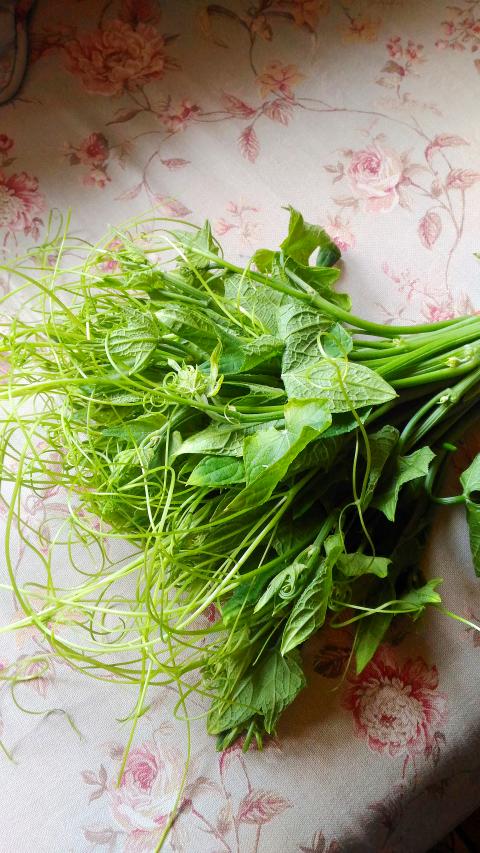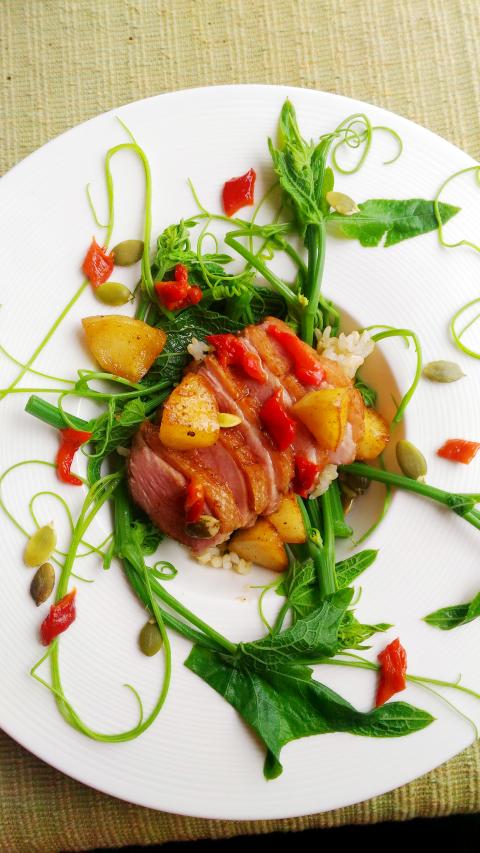Chayote is a native of Central and South America where it has long been cultivated for its pear-shaped gourd. It was introduced into China, possibly by the Spanish, some time in the early 20th century and has a minor place in Chinese cuisine.
The gourd is now used in the food of many nations, its robust growth allowing it to adapt well to many climates. Its ability to withstand Taiwan’s torrid summers with minimal supervision have made it popular, though here it is primarily cultivated for its vines, which are notable for their curly tendrils that have earned them the name dragon whiskers vegetable (龍鬚菜).
The leaves are firm and shaped like miniature maple leaves. Stems can be fibrous, and with slightly older plants, it can be advisable to break the stem and peal away the outer layer. Tender shoots can be cooked without further preparation.

photo: ian bartholomew
The relationship between the chayote gourd and the dragon whiskers vine was brought home to me over the last few weeks due to one of those learning experiences that life in Hualien is so full of.
A few rows of chayote had been planted in a nearby field. I knew it was chayote as the whole gourd is generally planted high up on the ploughed earth, perfectly visible to anyone passing. The plump green pears nestling in the dark earth looked almost appetizing.
Indeed, only a couple of days later the sweet chayote gourds were plundered by a wild boar, who clearly had quite a feast, necessitating a new planting, this time with traps and nets and dogs tethered at the corner of the field.

photo: ian bartholomew
There have been a number of late night raids on the field, with quite a bit of excitement. The wily creature always gets away, though not without injury.
Finally a specialist team from the mountains of Taitung was brought it with walkie-talkies, spears and a truckload of 20 dogs. These finally brought the boar to bay and it was eventually speared through the heart. The chayote crop was now safe, and as the hunters said, they were heading back for some nice roast pig.
Clearly chayote is as tasty to boars as it was to the Aztecs, who first cultivated the crop.
This is what passes for entertainment in the backwoods of Hualien. I had never made much of an effort to use chayote vine, but after such a boisterous and heroic defense of the chayote field, I really felt that I had to do more with it. Chayote vine was clearly an exciting vegetable.
Well, actually not.
Setting aside what can be done with the gourd for another day, the vine, which is widely available in traditional markets, is rather bland in flavor. Its main culinary appeal is in its crisp texture. Chayote vines are most often stir-fried, usually with pork. The one thing to bear in mind with this simple preparation is that the vines should be covered briefly in the pan allowing the vines to soften, as they can otherwise be unpalatably fibrous.
Another popular preparation is to blanch chayote vine in boiling water for a couple of minutes then shock them in ice before seasoning with sesame oil and white sesame seeds. Served cold, you can really bring the vegetable’s texture to the fore, and a plate of tender shoots makes for an excellent side dish for a summer meal.
Chayote vine is popular as a low maintenance vegetable to grow and thrives without or with minimal aid of fertilizers and pesticides. In the summer months, when many other green vegetables are heavily sprayed to keep them alive in the torrid heat, chayote seems to thrive. When prices for spinach, bok choy or other conventional veg skyrocket, and what is available probably is filthy with chemical residue, chayote vine is a great option for keeping greens on the table.
While not highly prized, it is much praised for its health benefits, with many local food and health Web sites lauding its antioxidant qualities and listing it among the best foods to prevent cancer. It is very high in dietary fiber, which is generally a good thing, but some doctors recommend that those with digestive problems should not over indulge.
But over-indulgence in chayote vine does not seem a very likely prospect. It simply isn’t that kind of vegetable. Blanched, it can be added to a western-style salad, but it tends to turn a bit yellow if it comes in contact with acids, so vinaigrettes should be avoided.
Duck breast with apples and chayote
Recipe
(serves two)
A simple dish that marries sweet, spiced apple with the crispiness of chayote for a light meal that is easy to prepare and packs in fruit, veg and meat.
Ingredients
2 small duck breasts
1 green apple, peeled, cored and diced
1 tsp paprika
1 tbsp sugar
2 tbsp cider vinegar
salt and pepper
1 small bunch chayote vine
1/2 bell pepper, diced
Directions
1. Prepare a large pot of boiling water and a large bowl of water and ice.
2. Place the chayote in boiling water and blanch for 2-3 minutes depending on how tender the shoots. Remove and shock in ice water.
3. Remove and drain. Set aside.
4. Score the skin of the duck into lozenges with a sharp knife. This will help in rendering down the fat under the skin. Season the duck breast generously with salt and pepper.
5. Place the duck breast skin side down in a cold pan. Cook skin side down on low heat until the skin is golden brown and crisp, about 6 minutes.
6. Turn over and cook on reverse side for 2-4 minutes. The duck should still be pink on the inside.
7. Remove the duck and set aside to rest for 5 minutes.
8. Add the apples to the pan with the duck oil and saute over medium heat. When they begin to color, add paprika and sugar. Stir to coat the apples evenly.
9. Add the cider vinegar and cook for a further 1-2 minutes until the sauce thickens.
10. Place the chayote in a bowl. Once the duck is rested, slice thinly with a sharp knife. Place duck slices over the chayote then top with apples and sauce. Garnish with diced sweet peppers.
Ian Bartholomew runs Ian’s Table, a small guesthouse in Hualien. He has lived in Taiwan for many years writing about the food scene and has decided that until you look at farming, you know nothing about the food you eat. He can be contacted at Hualien202@gmail.com.

Late last month Philippines Foreign Affairs Secretary Theresa Lazaro told the Philippine Senate that the nation has sufficient funds to evacuate the nearly 170,000 Filipino residents in Taiwan, 84 percent of whom are migrant workers, in the event of war. Agencies have been exploring evacuation scenarios since early this year, she said. She also observed that since the Philippines has only limited ships, the government is consulting security agencies for alternatives. Filipinos are a distant third in overall migrant worker population. Indonesia has over 248,000 workers, followed by roughly 240,000 Vietnamese. It should be noted that there are another 170,000

Hannah Liao (廖宸萱) recalls the harassment she experienced on dating apps, an experience that left her frightened and disgusted. “I’ve tried some voice-based dating apps,” the 30-year-old says. “Right away, some guys would say things like, ‘Wanna talk dirty?’ or ‘Wanna suck my d**k?’” she says. Liao’s story is not unique. Ministry of Health and Welfare statistics show a more than 50 percent rise in sexual assault cases related to online encounters over the past five years. In 2023 alone, women comprised 7,698 of the 9,413 reported victims. Faced with a dating landscape that can feel more predatory than promising, many in

“This is one of those rare bits of TikTok fitness advice with a lot of truth behind it,” says Bethan Crouse, performance nutritionist at Loughborough University. “Sometimes it’s taken a bit too literally, though! You see people chugging protein drinks as they’re scanning out of their gym.” Crouse recommends the athletes she works with consume 20-30g of protein within 30-60 minutes of finishing a resistance training session. “The act of exercising our muscles increases the breakdown of muscle proteins,” she says. “In order to restore, or hopefully improve them — and get gains such as increased muscle mass or strength —

“Far from being a rock or island … it turns out that the best metaphor to describe the human body is ‘sponge.’ We’re permeable,” write Rick Smith and Bruce Lourie in their book Slow Death By Rubber Duck: The Secret Danger of Everyday Things. While the permeability of our cells is key to being alive, it also means we absorb more potentially harmful substances than we realize. Studies have found a number of chemical residues in human breast milk, urine and water systems. Many of them are endocrine disruptors, which can interfere with the body’s natural hormones. “They can mimic, block